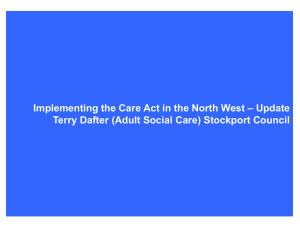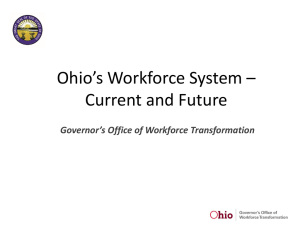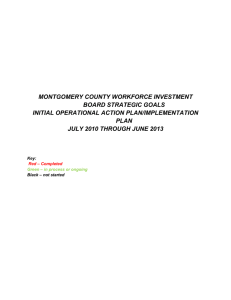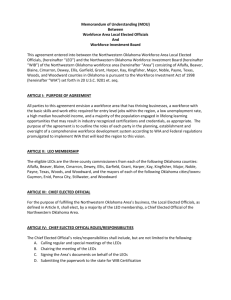Lessons from Year 1 of the Workforce Innovation Fund
advertisement
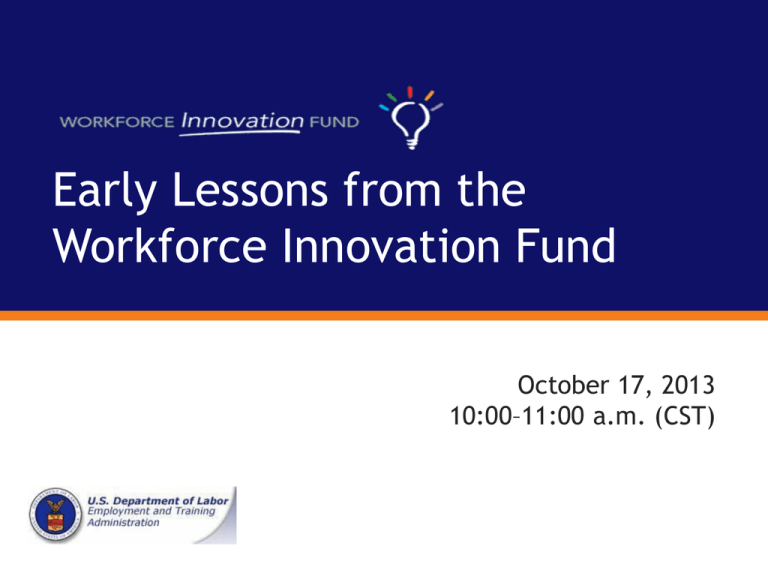
Early Lessons from the Workforce Innovation Fund October 17, 2013 10:00–11:00 a.m. (CST) Purpose • Provide a general overview Workforce Investment Fund theory and structure • Hear directly from practitioners who are using Workforce Investment Fund resources to strengthen career pathways and support the completion agenda • Discover whether currently funded projects offer lessons you can use • Discuss how to promote and support innovation in your own communities Agenda • Welcome & Introductions • Overview of Workforce Innovation Fund • Baltimore County’s ACE Project • Facilitated Group Discussion Presenters • Stephen J. Lynch, Facilitator/WIF National Technical Assistance Team Program Director, Jobs for the Future • Beth Arman, ACE Initiative Director of Technical Training, Community College of Baltimore County (CCBC,) Continuing Education Division • Kent Smedley, ACE Initiative Dean of Workforce Development, CCBC, Continuing Education Division Background of the Workforce Innovation Fund • Grant Program authorized by the Full-Year Continuing Appropriations Act, 2011 (P.L. 112-10) • Funds support innovative approaches to the design and delivery of employment and training services that generate long-term improvements in the performance of the public workforce system • One of several Federal grant programs that promote evidence-based design and independent third-party evaluation (like I3 and SIF) Goals • More efficient service delivery & better outcomes, especially for vulnerable populations and LTU • Support system reforms and innovations that promote cooperation across programs and funding streams • Build knowledge about effective practices through rigorous evaluation • Take effective practices to scale, and promote increased cost efficiency in the broader workforce system So Far… • 26 Projects funded with awards between $1.5m and $12m ▫ 12 Type A ▫ 8 Type B ▫ 6 Type C ▫ 8 Random Control Theory Studies ▫ 7 QED Studies ▫ 11 Outcomes Studies • Pay for Success round 1 awards to be announced What They Are Trying to Do Systems Change • Increase collaboration • Streamline services Technology • Data-driven decision-making • Cost-effective services Job-Seekers • Increase economic opportunity for vulnerable populations Business Customers • Better serve the needs of employers Who They Serve Network of Support ETA TA Coaches 26 Projects 3rd Party Evaluators NEC Categories of Intervention Data & Online Tools Systems & Policy Alignment Business Services Participant Services Cost Efficiency Change Serving Specific Populations Participant Services Includes: Primary or Secondary Focus for: Access to benefits Chicago Cook Workforce Partnership (IL) Assessment County of Orange (CA) Case management Utah WS (UT) Ensuring quality of training Workforce Central (WA) Outreach and recruitment Referral to services Supportive services Business Services Includes: Primary or Secondary Focus for: Business clients Alachua-Bradford (FL) Employer engagement County of Orange (CA) Employers informing training design, delivery and quality Fulton, Montgomery, Schoharie WIB (NY) Partnership with employers San Francisco (CA) Sector strategies West Central Jobs Partnership (PA) WDB of South Central Wisconsin (WI) Workforce Initiative Association (OH) Data & Online Tools Includes: Primary or Secondary Focus for: Data sharing agreements Chicago Cook Workforce Partnership (IL) Data integration and management Newark WIB (NJ) Distance learning and web-based tools Ohio Department of Jobs and Family Services (OH) Leveraging social media Pasco-Hernando WIB (FL) Real-time labor market information WDB of South Central Wisconsin (WI) Workforce Solutions (TX) Systems & Policy Alignment Includes: Primary or Secondary Focus for: Coordination across state agencies and policy issues Baltimore County (MD) City of Los Angeles (CA) Coordination with non-government partners and privately funded programs DeKalb County (GA) FMS WIB (NY) Gila River (AZ) Integrating ABE and skills training with college partners Illinois DCEO (IL) Metro North REB (MA) Integrating public workforce system with Adult Ed, Registered Apprenticeship, UI, TANF, colleges Ohio DJFS (OH) RI Dept. of Labor & Training (RI) Riverside EDA (CA) Integrating services at a regional level San Mateo (CA) Strengthening career pathways SkillSource Group, Inc. (VA) Translating policy to practice WestCentral Jobs Partnership (PA) Worksystems Inc. (OR) Cost Efficiency Includes: Primary or Secondary Focus for: Braided funding Metro North REB (MA) Cost reduction Newark WIB (NJ) Implementing performance-based funding Pasco-Hernando (FL) Leveraging private funding Utah WS (UT) Procurement and cost allocation strategies Serving Specific Populations Includes: Primary or Secondary Focus For: Disconnected youth Alachua-Bradford (FL) Entrepreneurship programs City of Los Angeles (CA) Housing/homelessness DeKalb County (GA) Limited English skills Riverside EDA (CA) Lower-skilled adults San Francisco (CA) Long-term unemployed San Mateo (CA) Registered Apprenticeship SkillSource Group (VA) Veterans Three Rivers WIB (PA) Workforce Central (WA) Workforce Solutions (TX) Worksystems Inc. (OR) Visit: innovation.workforce3one.org What are the top two barriers to innovation? 1. Set Thinking ▫ It is a natural tendency 2. Fear ▫ Many sources, common roots How do we move past the barriers? 1. Creativity ▫ Requires Usefulness 2. Confidence ▫ Being right and getting results gets the world onboard, so proceed until apprehended ACE Participants – Baltimore County Lead • • • • 9 Participating WIBs across the country Baltimore County WIB (BCDED) lead agency 6 Maryland WIBs Plus 3 WIBs in ▫ Georgia ▫ Connecticut ▫ Texas 21 Community College of Baltimore County • Training provider for Baltimore County ▫ Working with BCDED (LWIB agency) • 4 initial career training programs ▫ ▫ ▫ ▫ Dental Assistant Construction Pre-Apprenticeship Utility Installer Logistics Technician • Potential additional programs ▫ Certified Apartment Maintenance Technician ▫ CDL-B 22 Training Format • Each program has a well-defined career pathway • MI-BEST instructional format ▫ Based on I-BEST model from Washington • Combining Basic Skills/GED or ESOL training with occupational training ▫ ~50% added to occupational instruction hours • Randomization process to create 2 groups and test the effectiveness of training 23 Process recruitment to training • Marketing to attract applicants • Information and assessment session ▫ Math and reading assessments (CASAS) ▫ Used to determine suitability to move to next stage – determining eligibility • Complete background check and drug screen ▫ Results determine ability to move forward to randomization phase • 3-day workshop (job readiness and team skills) 24 ▫ Motivate students toward “learning” 25 Process – Continued…… • At end of 3-day workshop ▫ One-on-one interviews to determine final eligibility for randomization ▫ Prior to randomization, a variety of factors may determine if individual is unfit for ACE training Poor attendance, attitude, excessive social barriers etc. If so…..not eligible for randomization • Randomization 26 ▫ “In” – treatment group and enter ACE training ▫ “Out” – control group with business as usual towards training and seeking employment Lessons Learned • Selection of programs and target audience ▫ Is there sufficient job demand, high enough wages? Rejected Early Childhood Education - wages ▫ How long is the training, particularly after adding GED/ESOL, case management, etc.? Rejected Machinist – too long (and therefore too expensive for grant) ▫ Are we attracting the right audience? Construction: ESOL audience was working during the day; non-ESOL didn’t realize program wasn’t for them 27 Lessons Learned • Selection of partners and logistics ▫ Construction: government agency and stipends Importance of clear roles and responsibilities Importance of clear information to students upfront ▫ Utility installer: Private company had tried a limited pre-employment training program and realized they needed our help They have content knowledge, equipment, etc. and are happy to work with us – and we’re happy to work with such an organized partner 28 Lessons Learned • Schedule ▫ Time for co-instructors to work together before program starts Joint planning time (critical in I-BEST!) Learning to appreciate one another’s strengths ▫ Intensive is great, but 5 days/week can be too much Especially if students need case management, meetings with parole officers, etc. ▫ Match typical work schedule where possible Manufacturing example Construction example 29 Lessons Learned • Selection Process ▫ What criteria? Construction – physical ability Any grant-funded program: ability to work in U.S.; we have added background check and drug testing ▫ Selection at what point? We now use a short “vestibule” to check attendance and work ethic But vestibule should bear some resemblance to the training, include some hands-on 30 THANK YOU FOR ATTENDING! For more information on the Workforce Innovation Fund please visit: innovation.workforce3one.org






